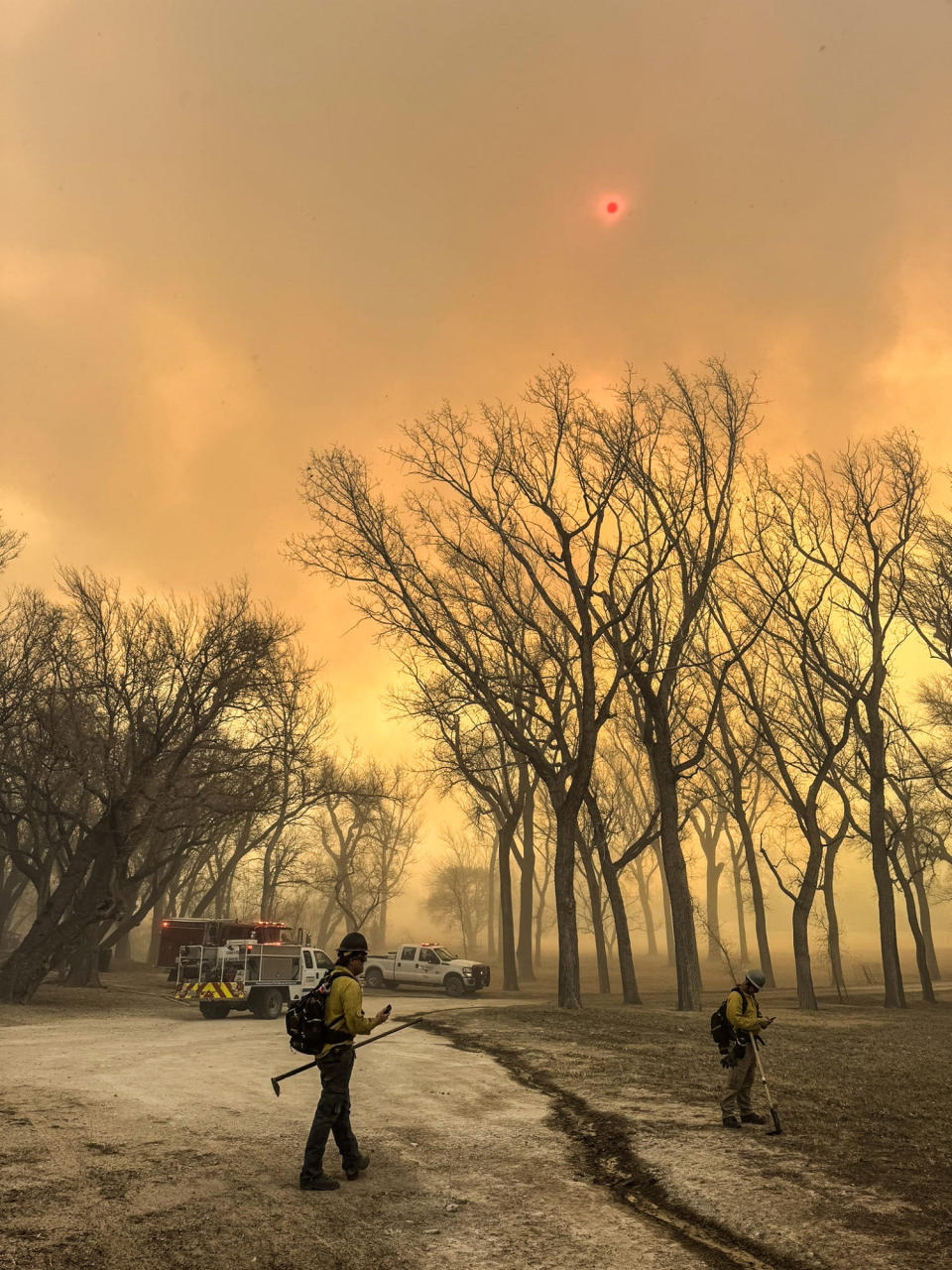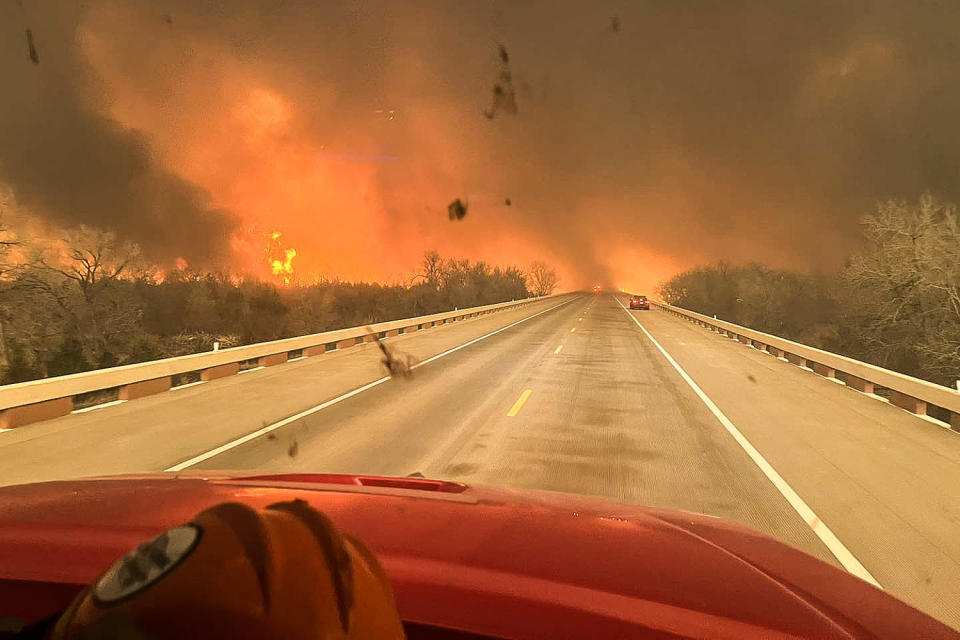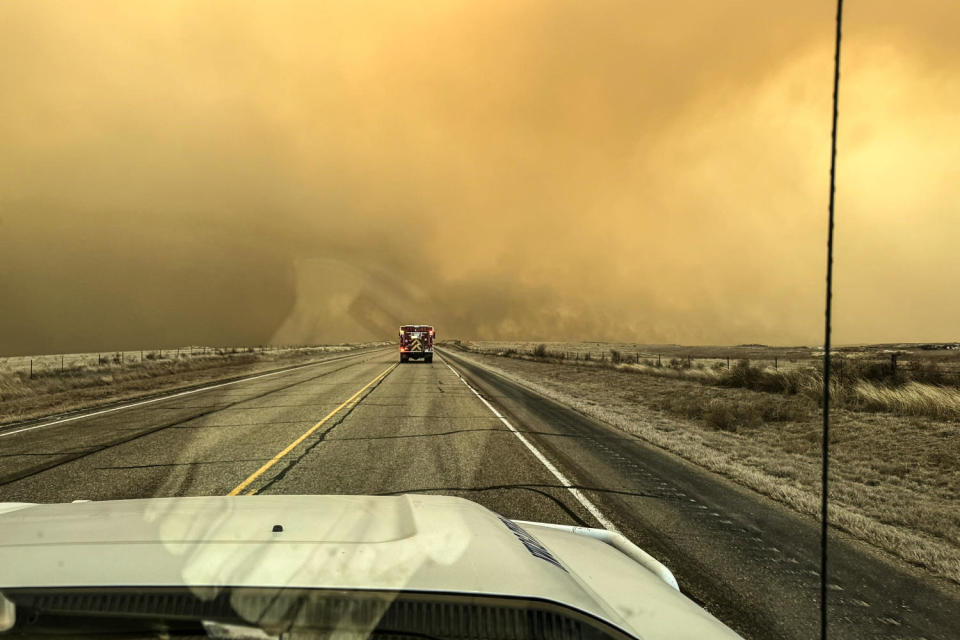Abnormally warm temperatures, dry grass and a sudden windy cold front combined to create conditions for the devastating wildfires that have raged in parts of Texas this week.
The winds that swept wildfires across the Texas Panhandle struck at the perfect time of day for destruction, “like a hurricane making landfall at high tide,” Texas state climatologist John Nielson-Gammon said. Hot, dry temperatures — the kind that can be caused by climate change — have helped create conditions for these fires to ignite, he added.
On Monday, temperatures reached the mid-80s in some parts of the state’s arid northern region, and several wildfires began burning.
The next day, Arctic air poured down from the north in a bitter cold front. Winds on both sides of that front — at times exceeding 50 miles per hour — sent flames roaring through dormant grasses, Nielsen-Gammon said. The cold front arrived in the late afternoon when wind speeds were highest, and also changed direction as it moved through, maximizing the fire’s rate of spread.
It is not clear how the fires started.

“The weather timing during the day was probably the worst possible,” Nielsen-Gammon said. “If a wildfire breaks out, this is the kind of weather pattern that will lead to it.”
The fires swept through the landscape so quickly that firefighters had little chance to control them.
“Those fires, all things considered, spread very quickly, for a wildfire. We have seen speeds between 5 and 10 mph,” said Christian Rangel, meteorologist with the National Weather Service in Amarillo. “The high winds really pushed these guys out into an uncontrollable state.”
The region’s terrain also played a role, with open terrain allowing the fires to spread quickly and also making it difficult to fight the fires.
Despite being largely flat, the area is characterized by sandy and grassy “broken terrain” that can be difficult to access, said Luke Kanclerz, chief of predictive services at the Texas A&M Forest Service. So once the fires swept across the plains, they quickly became difficult to control.
“A fire moving at about 5 miles per hour may not sound very fast, but when you have a large fire front and you’re trying to contain a large area, it pretty much outpaces firefighting efforts,” Kanclerz said.
The Texas Panhandle is no stranger to high winds and roller coaster temperature drops. But the fires would not have had the same chance of breaking out if not for unusually warm temperatures and dry conditions, made more likely by climate change.
“This particular event would have been less devastating if it had occurred a few decades ago at the same time,” Nielsen-Gammon said. “These high temperatures can occur earlier in the season and that happens when the grasses are normally dormant, so there is a lot of dry fuel available.”
John Abatzoglou, a climatologist at the University of California, Merced, said wind was the biggest factor in the size of the fires, which covered nearly 1 million acres, according to the federal wildfire tracking website Inciweb.
“This is primarily a wind-driven fire,” Abatzoglou said, adding that the role of climate change was “more subtle than we would generally think.”
Abatzoglou said the wind initially came from the west to spread the fires in the shape of an ellipse on the map, then shifted about 90 degrees and started pushing those lines south.
Abatzoglou said there is little solid evidence about how climate change is changing wind speeds.
Temperatures in the Borger area, near where the fires started, reached 85 degrees F on Monday, according to National Weather Service data.
“We set records in many of our climate locations,” Rangel said of the Amarillo forecast area, adding that relative humidity was at 20% or lower in many parts of the state and the landscape was on the verge of burning.


Parts of the Texas Panhandle are abnormally dry, according to the National Drought Monitor, but the landscape is not experiencing severe drought. In fact, it received a healthy dose of rainfall in late summer and fall, allowing the grasses to grow tall.
The above-normal growth increased the risk of wildfires during what is considered the dormant season for Texas grasses, which typically runs through winter until about mid-April.
Nielsen-Gammon said the heat hit early in the season and before vegetation could green up and become less likely to burn.
“This time we didn’t need a drought to get dry fuels,” Nielsen-Gammon said. “We are in the dormant season for grasses, there are still dead grasses.”
Firefighting is becoming more common in the western United States. The nonprofit Climate Central calculated how the number of days with fire services in communities across the United States has shifted from 1973 to 2022, using weather station data and measurements of temperature, wind and relative humidity.
By the end of the group’s five-decade research period, some parts of Texas, including the High Plains and Panhandle, had twice as many fire days, according to Climate Central. The High Plains has now seen more than a month of extra fire days, the report said.


Texas has a complicated future when it comes to wildfires, according to a report on the state’s future with extreme weather written by Nielsen-Gammon and colleagues.
However, researchers expect dry conditions to extend the wildfire season, especially in places like East Texas where conditions are less dry. In the future, wildfire risk could increase more slowly in West Texas and the Panhandle as plants struggle to grow in drier climates.
Nielsen-Gammon said he worries that fast-moving wildfires may become more common in Central and East Texas as conditions become drier, putting the Austin, San Antonio and Dallas-Fort Worth areas at greater risk.
“The risks of loss of life are greater there and that would be the case in places where people are not used to forest fires,” he said.
This article was originally published on NBCNews.com